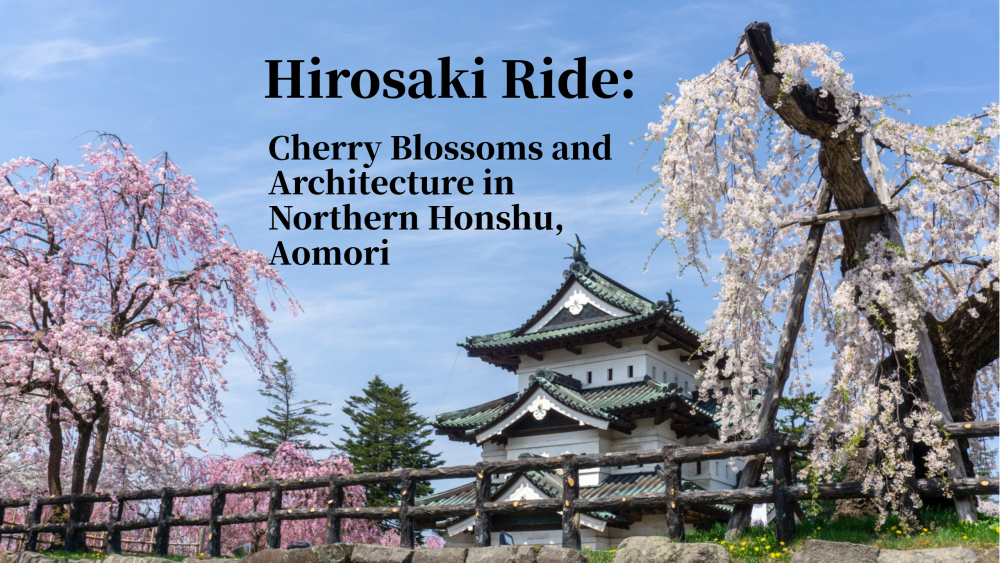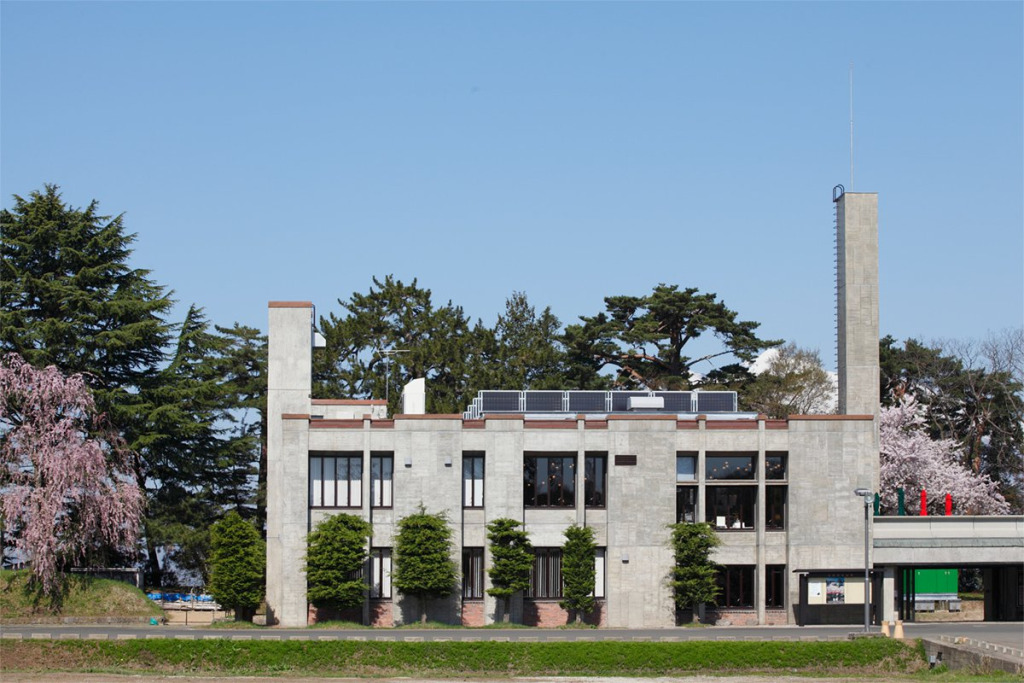
Enjoyable even in winter! Okinawa Seaside Cycling

Aomori Prefecture, located at the northernmost tip of Honshu(the main island of Japan), offers food of the sea and mountains, and rich nature throughout the year. Its cherry blossom spots come alive in spring. This cherry blossom ride explores Hirosaki City, a castle town that flourished since the Edo period. Enjoy the cherry blossoms at Hirosaki Castle, soothe your soul, and conclude the ride at the 800-year-old Owani Onsen for a relaxing finale. Indulge in the rich culinary offerings of spring in Aomori, from fruits and vegetables to seafood. Embark on a journey through spring in Aomori, where nature, culture, and cuisine blend harmoniously.
1. Starting from Aomori Airport
2. A Brief Introduction Before That
3. Heading South to Begin
4. Aomori, Known for Its Apples
5. Straight to Hirosaki Castle
6. Hirosaki Park, a Cherry Blossom Wonderland
7. Enjoying Lunch at the Hirosaki Cherry Blossom Festival
8. Admiring Modern Architecture in Japan
9. Renovation by Young Architects × Art Museum
10. Heading to the Hot Springs with Aomori’s Mt. Fuji in the Background
11. Present within History
Arrival at Aomori Airport. This is where our journey begins. Aomori Airport features a temporary cycle station since 2021. Equipped with space for assembling and disassembling bicycles, cycle racks, and even an air pump, it’s a cyclist-friendly airport (usually available from late April to mid-October). Located in Aomori City, the airport overlooks the sea to the north, with Hokkaido’s vast land lying beyond. However, our destination lies to the south – Hirosaki City, once a thriving castle town during the Edo period. Our destination: the famous Hirosaki Castle, renowned for its cherry blossoms. Now, let’s get ready and embark on our journey.

While not included in this route, a must-visit when in Aomori Prefecture is the Aomori Museum of Art. Its most famous feature is undoubtedly the large dog monument, a creation by the globally renowned artist, Yoshitomo Nara, who hails from Hirosaki City, our destination on this ride. Known as “Aomori-Ken (Aomori Dog),” this artwork appears massive in photos, but its sheer size is even more impressive in person. Despite its imposing presence, there’s a certain charm to it, and you might find yourself into the space with this white dog. Aomori Prefecture has produced various artists, including the printmaker Shiko Munakata, but nothing quite matches the artistic Nebuta festival car. If you have the chance, be sure to witness them. By the way, there are two festivals: the Aomori Nebuta Festival in Aomori City and the Hirosaki Neputa Festival in Hirosaki City. Please note the difference between “Nebuta” and “Neputa.”


Putting aside any digressions, let’s embark on the Hirosaki route. Once you leave Aomori Airport, head towards Route 7 via Prefectural Route 27. One of the first notable sights you’ll encounter is the “trees.” Aomori sits at the northern part of Japan, so even in April, the average temperature hovers around 8 degrees Celsius. Mornings and evenings can feel surprisingly chilly, making you wonder if spring has truly arrived in Japan. However, the air is crisp and refreshing, offering a pleasant riding experience without the dampness. While there are some undulations, they are relatively gentle, allowing you to enjoy a comfortable ride while admiring the expanses of forests on either side. Cutting through the wind, this ride perfectly encapsulates the sensation.

An ideal first rest stop along the way is “Michi-no-Eki Namioka.” Located just a short distance south from Prefectural Route 27 onto Route 7, it’s a roadside station known for its top satisfaction rating among Aomori Prefecture’s roadside stations (according to the Jalan Nationwide Roadside Station Satisfaction Ranking 2022). Now, apples are one of Aomori’s representative foods. Aomori produces the highest volume of apples in Japan, with about 60% of Japan’s apples being from Aomori Prefecture. It’s truly the kingdom of apples. Moreover, the restaurant at “Michi-no-Eki Namioka” is called “Apple Hill.” With a name like that, you can’t resist trying their offerings. Upon perusing the menu, you’ll find it: their specialty apple pie made with Aomori apples, of course. Its taste? Juicy, sweet, with a refreshing tartness… Words can’t do it justice; it’s something you have to taste for yourself.

After the break, our next destination is one of the main events of this trip: Hirosaki Castle. It’s about 20 kilometers straight ahead, so we’ll ride through in one go. Crossing the railroad crossing of the Gono Line, you’ll start to see the streets that once thrived as the castle town. Continuing on, you’ll catch sight of the castle tower of Hirosaki Castle, hailed as one of “Japan’s Seven Famous Castles” by the historical novelist Ryotaro Shiba in one of his works. The castle tower, built during the Edo period, still stands today, offering a glimpse of its original form, with restorations done to other parts such as the turrets over the years.

And now, the cherry blossoms. Hirosaki Park, spreading beneath Hirosaki Castle, has been selected as one of Japan’s Top 100 Cherry Blossom Viewing Spots, boasting around 50 varieties and 2,600 cherry blossom trees in full bloom during spring. The location is superb. Gazing up at the cherry blossoms stretching across the sky with Hirosaki Castle in the background feels like traveling back in time. While Hirosaki Park was opened to the public in 1895, one can’t help but imagine the scenes from the Edo period, where people might have looked down from the castle, sipping sake and enjoying delicious treats while admiring the pink hues of the cherry blossoms.

By the way, it seems that there are “winter-blooming cherry blossoms” in Hirosaki Park as well. During winter, snow accumulates on the cherry blossom branches. They are illuminated with pink lights, allowing visitors to see the winter cherry blossoms blooming only at night.
Now, it’s time for a lunch break. Hirosaki, once a thriving castle town, had vibrant trade, and seafood from the sea was abundant. Of course, there’s also a variety of delicious vegetables and fruits available. So, we couldn’t resist finding a tempting restaurant. After some consideration, we decided to have an outdoor lunch in the cherry blossom-filled Hirosaki Park. The Hirosaki Cherry Blossom Festival takes place in Hirosaki Park from April 12th to May 5th. It’s expected that the cherry blossoms will be in full bloom around April 20th. From then until early May, different varieties of cherry blossoms will continuously be in full bloom. Having lunch while gazing at both the falling cherry blossoms and the full bloom ones is truly a luxurious experience.

While relaxing outdoors is nice, let’s take a stroll through the park to aid digestion. As you do, you’ll come across a modern building. Upon closer inspection, it’s the Civic Hall. The Hirosaki Civic Hall was constructed in 1964 by Kunio Maekawa, who studied under Le Corbusier and Antonin Raymond, leading the Japanese architectural scene as a pioneer of modernist architecture. It’s quite luxurious to have such a modern building serve as a civic hall. During World War II, Hirosaki served as a base for the Japanese army, fostering various exchanges with Tokyo, the capital. It’s no wonder that the city is dotted with architecturally elaborate structures.

Now, after a refreshing stroll through the park, it’s time to start our ride towards the goal: Owani Onsen. Owani Onsen is located south of Hirosaki Castle. As you cycle along, one of the first sights you’ll see is the Hirosaki Museum of Contemporary Art. This museum building was originally constructed about 100 years ago as a sake brewery. After the war, it was used as a cider factory, utilizing apples, a specialty of Aomori. However, it fell out of use over time. To preserve the legacy of modern industry for the future, architect Tsuyoshi Tane, known for his work on the design of the Estonian National Museum utilizing an old airport runway, led its renovation, transforming it into a museum.


Then it’s a swift ride towards the goal, the hot springs. From the Hirosaki Museum of Contemporary Art to Owani Onsen is approximately a 13-kilometer journey. With the majestic presence of Mount Iwaki, also known as Tsugaru Fuji, at our backs, we head towards the hot springs. Interestingly, Owani Onsen is famous for “moyashi,”(bean sprouts). Utilizing the heat and water from the hot springs, they are grown using a unique cultivation method that has been practiced for over 350 years, making them a traditional vegetable in the region. Their distinctive feature is their crisp texture, which is achieved through a secret technique called “onsen jime,” which cannot be replicated in conventional hydroponic cultivation. While bean sprouts are often relegated to a supporting role, here they take center stage. Be sure to give them a try.


And here we are, the finish line: Owani Onsen. Owani Onsen boasts a long history, said to have been established 800 years ago. Alongside flows the pristine river, Hirakawa, offering yet another luxurious setting. During the Edo period, it served as a therapeutic hot spring resort for the Tsugaru domain lords, who frequently visited. It was also bustling with locals seeking medical treatment. The hotel at our destination, “Hoshino Resorts KAI Tsugaru,” is conveniently located near Owani Onsen Station. It’s a perfect blend of tradition and modernity, where the present seamlessly merges into the 800-year-old history. Relax in the hot springs and indulge in delicious Oma tuna. Welcome to a “luxurious” 50-kilometer journey, savoring the delights of the northernmost tip of Honshu.

🚲本日のライド行程
Profile

Kuniaki Ebinuma
Editor and writer. Born in Saitama Prefecture. Became tired of city life and relocated to Niigata Prefecture. Enjoys weekend hot spring life, visiting various hot springs everywhere. Recently made a U-turn and returned to city life after a long time. Despite feeling a bit disoriented in the city again, exploring interesting spots that were overlooked before the relocation.
Post Date:2024.05.02